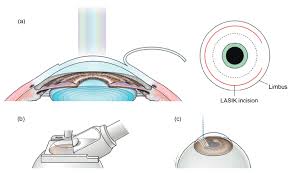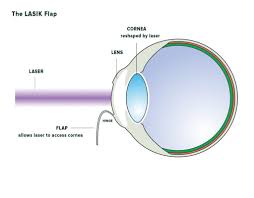Table of Contents
ToggleWhen patients consider LASIK (Laser-Assisted In Situ Keratomileusis) as a vision correction option, they often dream of a life free from glasses or contact lenses. However, as with any medical procedure, LASIK carries its own set of potential risks and complications.
One such concern that occasionally arises is the issue of permanent glare.
This blog post delves into the phenomenon of permanent glare after LASIK, providing valuable insights for LASIK patients, eye care professionals, and those considering vision correction surgery.

What is LASIK?
LASIK (Laser-Assisted In Situ Keratomileusis) is a popular refractive surgery designed to correct vision problems such as myopia (nearsightedness), hyperopia (farsightedness), and astigmatism. The procedure entails using a laser to reshape the cornea, the eye’s clear front part, which allows light to be properly focused onto the retina, resulting in clearer vision.
While LASIK is generally safe and effective, it’s important to be aware of potential side effects, one of which is glare.
What is Permanent Glare?
Permanent glare is a visual phenomenon where bright lights, such as headlights, streetlights, or other illuminated objects, appear to have an extended halo or starburst effect.
While some degree of glare is common immediately after LASIK surgery and usually diminishes over time, in rare cases, this condition can persist for months or even years, causing discomfort and impaired vision, particularly in low-light conditions.
Causes of Permanent Glare After LASIK
Understanding the root causes of permanent glare can help manage expectations and mitigate risks. Several factors contribute to this complication:
- Post-Surgical Healing: One of the primary causes of glare after LASIK is the healing process. Immediately following the surgery, the corneal tissue needs time to heal. During this period, irregularities in the corneal surface can cause light to scatter, leading to glare. For most patients, this is a temporary issue that resolves within a few weeks to months.
- Pupil Size: Patients with larger pupils are more prone to experiencing glare after LASIK. When the pupil expands in low-light conditions, it can extend beyond the area of the cornea that was treated, exposing the untreated periphery. This can cause light to scatter, leading to glare.
- Irregular Corneal Surface: Another cause of permanent glare could be an irregular corneal surface post-surgery. If the cornea does not heal symmetrically, it can result in light refracting improperly, causing glare. This is often due to uneven tissue removal by the laser.
- Residual Refractive Error: If the LASIK procedure does not completely correct the refractive error, patients might experience visual disturbances, including glare.
- Dry Eyes: Post-LASIK dryness is a common side effect that can affect the quality of vision, leading to glare. Dry eyes interfere with the tear film’s stability, causing light to scatter unevenly.
- Higher-Order Aberrations: LASIK can sometimes induce higher-order aberrations (HOAs) that are not corrected by glasses or contact lenses. These aberrations can contribute to glare and other visual distortions.
- Epithelial Ingrowth: Epithelial ingrowth is a condition where cells from the outer layer of the cornea grow underneath the flap created during LASIK surgery. This can cause a rough corneal surface, leading to irregular light refraction and glare.
- Under or Over-correction: In some cases, LASIK may not completely correct the refractive error, or it may overcorrect it. Both under-correction and over-correction can result in visual disturbances, including glare.
Symptoms of Permanent Glare
Recognizing the symptoms of permanent glare is crucial for seeking timely medical intervention. Common symptoms include:
- Starbursts: Radiating lines around lights, especially noticeable at night.
- Halos: Circular bursts of light around headlights, street lamps, and other bright sources.
- Increased Light Sensitivity: Difficulty adapting to bright lights, leading to discomfort and squinting.
- Blurred Vision: Fluctuating clarity, especially in dim lighting.
- Difficulty Driving at Night: Glare can make it challenging to see road signs, other vehicles, and pedestrians in low-light conditions.
Risk Factors for Permanent Glare
While anyone undergoing LASIK can potentially experience permanent glare, certain factors may increase this risk:
- High Prescriptions: Patients with higher degrees of myopia or hyperopia may have a greater risk.
- Pre-existing Dry Eye Syndrome: Those with dry eyes before surgery are more likely to experience post-operative complications.
- Large Pupils: Patients with naturally larger pupils may be more prone to glare issues.
- Thin Corneas: A thinner corneal layer may lead to more irregularities after reshaping.
Prevention and Screening
Preventing permanent glare starts with thorough pre-operative evaluations and selecting the right candidates for LASIK. Here are some preventative measures and screening techniques:
- Comprehensive Eye Exam: A detailed pre-operative examination can identify factors that might increase the risk of glare, such as high refractive errors, large pupil size, and pre-existing dry eye conditions.
- Advanced LASIK Technology: Using modern LASIK technologies like wavefront-guided or topography-guided LASIK can help minimize higher-order aberrations and improve overall visual outcomes.
- Customized Treatment Plans: Personalized treatment plans based on the patient’s unique ocular anatomy and visual needs can reduce the likelihood of post-operative glare.
- Patient Education: Informing patients about potential risks, including glare, helps manage expectations. Patients must be aware that not all visual disturbances resolve immediately.
Management of Permanent Glare
If permanent glare does occur, several strategies can be employed to manage and alleviate the condition:
- Medication and Lubrication: Using prescribed eye drops and artificial tears can improve the tear film and reduce symptoms related to dry eyes, thereby minimizing glare.
- Specialized Eyewear: Wearing glasses with anti-reflective coatings or using nighttime driving glasses can help reduce the impact of glare.
- Refractive Enhancements: In some cases, a secondary LASIK procedure or other refractive surgeries might be necessary to address residual refractive errors or corneal irregularities.
- Corneal Collagen Cross-Linking (CXL): CXL can sometimes stabilize the corneal surface, reducing irregularities that cause glare.
- Therapeutic Contact Lenses: Specialty lenses can help smooth the corneal surface and improve visual quality, reducing glare symptoms.
- Continued Follow-Up: Regular follow-up visits allow eye care professionals to monitor progress and make any necessary adjustments to the treatment plan.
Living with Permanent Glare
For some patients, permanent glare may not be entirely avoidable. However, there are strategies to manage it effectively:
- Optimize Lighting: Use dim lighting indoors and install proper lighting in areas where you need clear vision.
- Limit Night Driving: If possible, avoid driving at night, or use glare-reducing glasses.
- Regular Eye Check-ups: Keep up with regular eye exams to monitor your condition and adjust treatments as necessary.
Wrapping Up
Permanent glare after LASIK, while rare, is a significant concern for both patients and eye care professionals. Understanding its causes, taking preventative measures, and employing effective management strategies can greatly enhance patient outcomes. LASIK remains a highly successful and safe procedure for vision correction, but as with any medical intervention, being well-informed about potential complications ensures better preparedness and care.
For those considering LASIK, it’s crucial to have an open dialogue with your eye care professional about all potential risks, including glare, and to ensure that a comprehensive pre-operative assessment is conducted. By doing so, you can make informed decisions and enjoy the numerous benefits that LASIK has to offer.
If you found this information helpful, please share it with others who may benefit from understanding the complexities of LASIK and its potential side effects. Your vision is precious – make informed choices to protect it!













